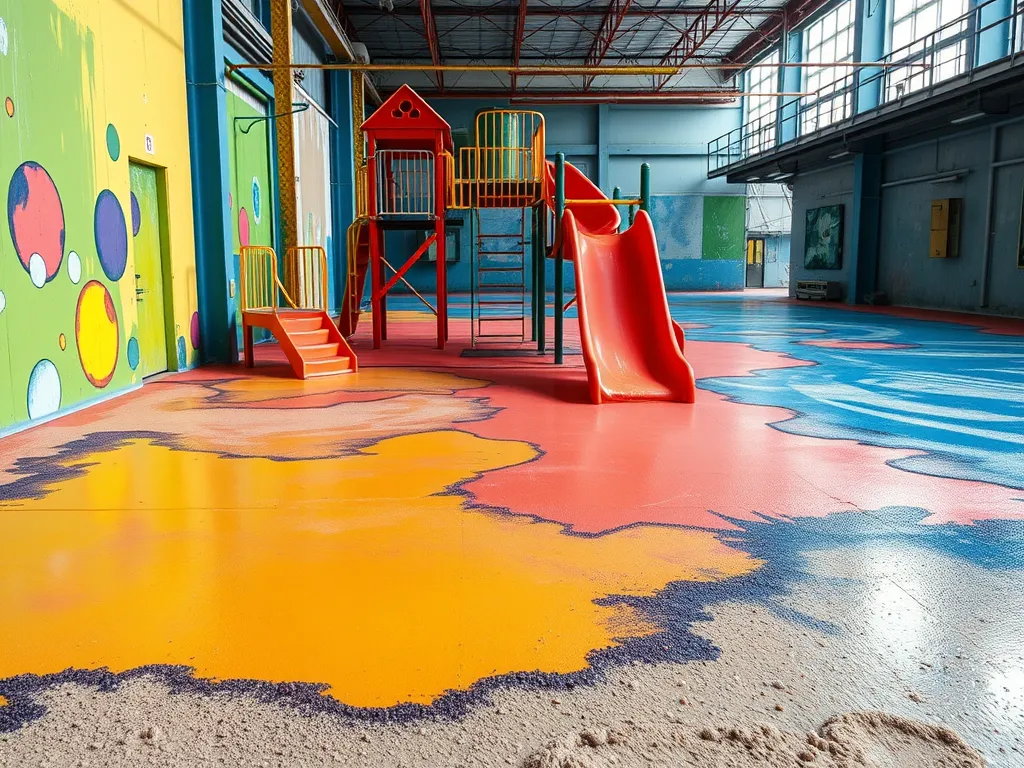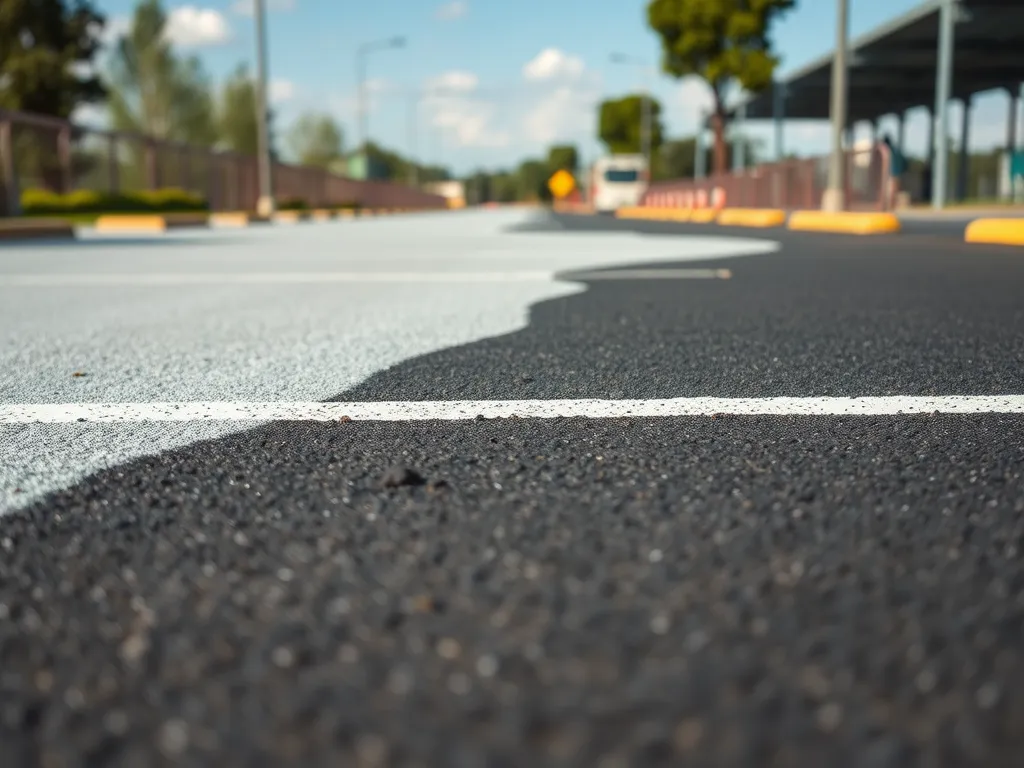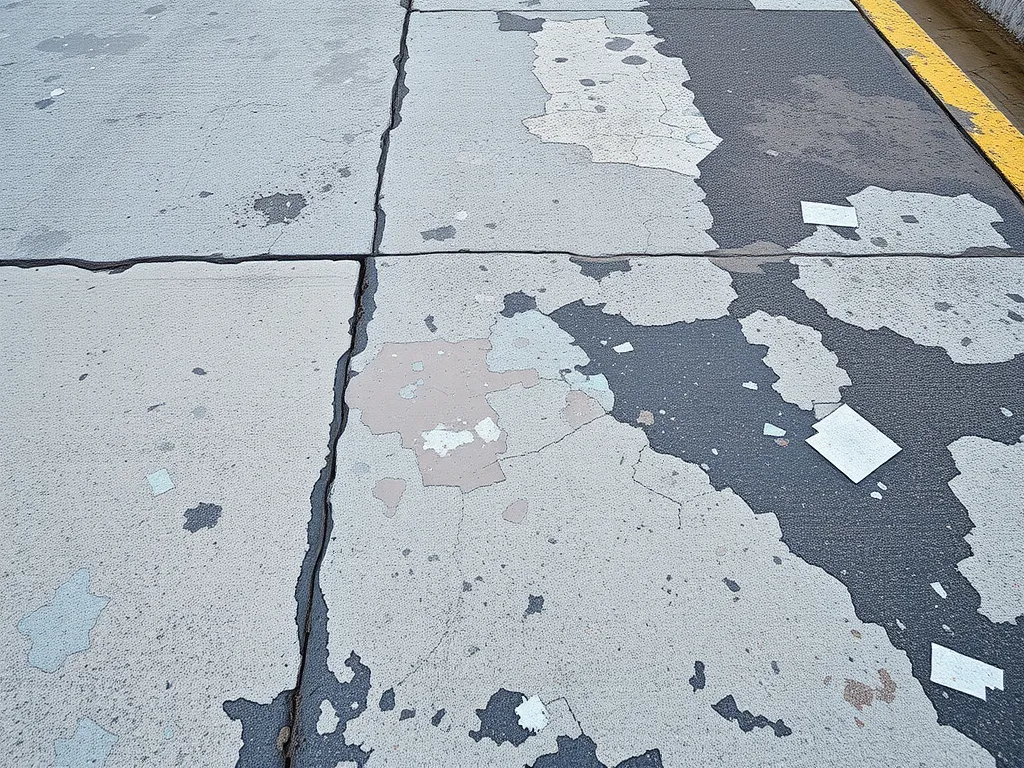Can You Paint Asphalt? Your Complete Guide to Lasting Results
Published on: October 4, 2025 | Last Updated: April 14, 2025
Written By: George Voss
Yes, you can paint asphalt surfaces with the right materials. Use acrylic, latex, or epoxy paints specifically designed for asphalt. Unlike concrete, asphalt contains oil-based materials, so standard paints may peel or fade. Proper preparation—cleaning debris, repairing cracks, and applying a primer—ensures paint adhesion and durability up to 3-5 years.
This guide explains how to choose water-based or oil-based paints, prep surfaces, apply paint correctly, and maintain results. Learn which paints work best for driveways, parking lots, or playgrounds. Get answers on color options, drying times (24-48 hours), and top products like Watco Asphalt Paint. Avoid common mistakes and achieve professional-grade finishes.
Contents
- Understanding the Basics Of Asphalt Painting
- Types Of Paint Suitable for Asphalt
- Preparing Asphalt for Painting
- Step-by-step Process for Painting Asphalt
- Maintenance and Longevity Of Painted Asphalt
- Pros and Cons Of Painting Asphalt
- Environmental Considerations for Asphalt Paint
- Frequently Asked Questions (FAQs)
- Closing Thoughts
- Additional Resources for You:
Understanding the Basics Of Asphalt Painting
Painting asphalt requires specialized products designed for porous, oil-rich surfaces. Unlike concrete, asphalt’s bitumen content demands paints that bond without degrading from heat or vehicle fluids.
What is Asphalt Paint?
Asphalt paint is a flexible, weather-resistant coating formulated with acrylic resins, alkyds, or coal tar. These binders adhere to asphalt’s rough texture while resisting UV rays and temperature shifts. Brands like Rust-Oleum® or BEHR® offer variants with 60-70% solids content for better coverage (250-400 sq. ft. per gallon). Drying times range 24-48 hours at 50-90°F.
Common Applications Of Painting Asphalt
Painting asphalt surfaces enhances safety, visibility, and longevity. It’s used in both residential and commercial settings where durability meets design needs.
Driveways, Parking Lots, Roads, and Playgrounds
- Driveways: High-traffic areas benefit from acrylic latex paint, which withstands vehicle weight and oil spills. Dark hues like jet black or slate gray blend with existing pavement.
- Parking Lots: Traffic line striping paints (ASTM D6625-compliant) use reflective glass beads for night visibility. Yellow and white are standard for directional markers.
- Roads: Municipalities apply thermoplastic markings (melted at 400°F) for lane divisions. These last 3-5 years under heavy traffic.
- Playgrounds: Non-slip acrylics in bright colors (red, blue, green) create safe play zones. Textured coatings prevent slips during rain.
Beyond aesthetics, painted asphalt reduces surface temperatures by up to 15°F compared to untreated pavement. With applications ranging from residential driveways to highways, selecting the right paint type directly impacts performance. Let’s explore your material options.
Types Of Paint Suitable for Asphalt
Choosing the right paint determines how long your project lasts and how well it holds up against traffic and weather. Asphalt surfaces need flexible, UV-resistant coatings that bond with bitumen-rich surfaces. Let’s break down the top options for driveways, roads, parking lots, and alleys.
Water-based Vs. Oil-based Asphalt Paints
Water-based asphalt paints dry faster (1-2 hours) and emit fewer fumes, making them ideal for residential areas like driveways or playgrounds. They resist fading but may need reapplication every 1-2 years. Oil-based alternatives offer deeper penetration into asphalt’s porous texture, lasting up to 3-5 years. They take 6-8 hours to dry and release higher volatile organic compounds (VOCs), requiring proper ventilation during use.
- Water-based: Low odor, eco-friendly, best for light traffic
- Oil-based: High durability, suited for heavy-use zones like roads
Acrylic Paint for Asphalt Surfaces
Acrylics are a top pick for painting asphalt driveways or parking lots. These paints flex with temperature shifts, reducing cracks in freezing winters or scorching summers. High-quality acrylics like Rust-Oleum® Professional Grade resist tire marks and oil spills. They cover 250-300 sq ft per gallon and come in black, gray, red, or blue. Apply with rollers or sprayers for even results.
Epoxy and Latex Options for Durability
Epoxy blends create industrial-strength coatings for asphalt roads or airport tarmacs. Two-part epoxy systems withstand chemicals and heavy loads up to 5,000 PSI. Latex paints are budget-friendly for playgrounds or alleys, mixing well with sand for slip resistance. Both types cure fully in 24-48 hours. Expect 200-250 sq ft coverage per gallon.
- Epoxy: 10+ year lifespan, needs professional mixing
- Latex: Easy DIY application, lasts 3-4 years
Proper prep work ensures these paints stick. Let’s explore how to get your surface ready.

Preparing Asphalt for Painting
Proper groundwork forms the foundation for long-lasting color on blacktop. Skipping preparation risks flaking, peeling, or rapid fading within months.
Cleaning and Degreasing the Surface
Start by blasting dirt with a 2500-3000 PSI pressure washer. Mix 1 cup trisodium phosphate (TSP) per gallon of water for oil stains. Scrub stubborn spots using stiff bristle brushes. Oil residue blocks paint adhesion—skip this step, and coatings fail within weeks. Allow 24 hours for full drying post-wash.
Repairing Cracks and Damaged Areas
Fill gaps wider than 1/8″ with asphalt crack filler or cold patch compound. Smooth latex-based sealants using a putty knife for hairline fractures. Compact potholes with tamper tools, adding layers until flush with surrounding pavement. Wait 24 hours for materials to set—painting over fresh repairs causes bubbling.
Ensuring a Smooth and Dry Surface
Sand rough patches with 60-grit discs on orbital sanders. Perform a moisture test: tape plastic sheeting to pavement overnight. Condensation means waiting 24-48 more hours. Paint only when temps stay above 50°F—cold surfaces prevent binding. Humidity below 70% speeds drying.
With a fully prepped surface, you’re ready to move on to application techniques and material selection for lasting asphalt color.
Also See: Cooling Vs Curing in Asphalt: Key Differences
Step-by-step Process for Painting Asphalt
Proper application determines whether painted asphalt lasts 1-3 years or fails within months. Follow these steps to achieve professional-grade results.
Choosing the Right Tools and Materials
Use acrylic or latex-based paints designed for asphalt surfaces—they flex with temperature changes. For driveways or parking lots, select traffic-grade paints with skid resistance. Essential tools include:
| Tool | Purpose |
|---|---|
| Stiff-bristle broom | Remove debris |
| Asphalt primer | Improve adhesion |
| Airless sprayer (2000+ PSI) | Fast coverage |
| Squeegee or roller | Detail work |
Budget $0.15-$0.35 per square foot for materials. Buy 10% extra for touch-ups.
Techniques for Even Coverage on Asphalt
Start at the farthest point from your exit to avoid stepping on wet paint. Apply primer first if the surface has oil stains or cracks. For sprayers:
- Hold nozzle 12-18 inches from surface
- Move at 3 feet per second
- Overlap passes by 50%
Use a roller for edges near grass or walls. Apply two thin coats instead of one thick layer—wait 2-4 hours between coats.
Drying and Curing Time Guidelines
Drying times vary by product and weather:
| Paint Type | Dry to Touch | Full Cure |
|---|---|---|
| Water-based | 1-2 hours | 24 hours |
| Epoxy | 4-6 hours | 72 hours |
Keep temperatures above 50°F during application. Avoid rain for 48 hours post-painting. Foot traffic can resume after 12 hours; wait 72 hours for vehicles.
Proper application sets the stage for lasting results—but maintenance decides its lifespan. Next, we’ll break down strategies to keep your painted asphalt looking sharp.

Maintenance and Longevity Of Painted Asphalt
Keeping painted asphalt surfaces looking fresh requires regular upkeep. Proper care extends color vibrancy and prevents premature wear.
How Long Does Asphalt Paint Last?
Durability depends on traffic levels, climate, and paint type. Water-based acrylics typically last 1-3 years. Solvent-based variants like epoxy endure 3-5 years with proper application. High-traffic zones like parking lots or roads may need touch-ups every 6-12 months. Applying sealant every 24 months adds protective layers, boosting lifespan by 40-60%.
| Paint Type | Lifespan | Ideal Use |
|---|---|---|
| Acrylic | 1-3 years | Driveways, playgrounds |
| Epoxy | 3-5 years | Parking lots, roads |
| Latex | 2-4 years | Residential surfaces |
Cleaning and Preserving Painted Surfaces
Sweep debris weekly using stiff-bristle brooms. Pressure wash at 1,200-1,500 PSI every 90 days to remove embedded dirt. Treat oil stains immediately with trisodium phosphate (TSP) solutions. Avoid bleach or ammonia—these degrade binders in asphalt paint.
Reapply clear sealant every 18-24 months. This shields against UV rays and salt damage. In snowy regions, use calcium chloride instead of rock salt to prevent paint cracking.
Regular maintenance keeps surfaces like driveways and alleys looking sharp. Evaluating performance against wear factors ensures lasting results.
While upkeep preserves appearance, weighing benefits against limitations determines if painting asphalt fits your needs.
Pros and Cons Of Painting Asphalt
Coloring blacktop surfaces offers both functional benefits and challenges. Below, we break down key factors to weigh before starting your project.
Advantages Of Enhancing Asphalt Appearance
Injecting color into gray or faded surfaces boosts curb appeal instantly. Brightly painted lines in parking lots improve traffic flow, while custom designs on driveways personalize properties. High-quality products like epoxy-modified coatings block UV rays, slowing surface oxidation. Reflective paints lower heat retention by up to 15°F, reducing urban heat island effects. For roads, colored bike lanes or crosswalks heighten visibility, cutting collision risks by 23% according to Federal Highway Administration studies.
Potential Drawbacks to Consider
Oil-based options may become slippery when wet, creating safety hazards on slopes or playgrounds. Without proper prep—power washing, crack filling, primer application—paint peels within months under heavy tires or foot traffic. Temperature swings cause expansion-contraction cycles, leading to flaking. Budget for recoating every 1-3 years; budget brands fade faster under sun exposure. Disposal of solvents or lead-containing products requires certified facilities to prevent soil contamination.
Balancing visual upgrades with long-term upkeep needs ensures lasting results. Next, let’s explore how eco-conscious choices impact your paving projects.

Environmental Considerations for Asphalt Paint
Painting asphalt surfaces impacts local ecosystems and waste streams. Selecting responsible materials and disposal methods minimizes harm while maintaining vibrant results.
Eco-friendly Paint Options
Low-VOC (volatile organic compound) paints emit fewer toxic fumes during application. Water-based acrylics and latex formulas dominate this category, with VOC levels below 50 grams per liter. Brands like ECOS Paints and Benjamin Moore Ultra Spec® offer asphalt-grade options meeting LEED standards. Recycled-content paints, containing 20-40% post-consumer materials, reduce resource extraction. Though costing 10-15% more than conventional paints, these choices prevent 3-5 pounds of airborne toxins per gallon released.
Safe Disposal Of Materials
Leftover oil-based asphalt paint requires handling as hazardous waste. Many counties provide Household Hazardous Waste (HHW) drop-off sites—check local regulations via EPA databases. For water-based paints, dry cans completely before landfill disposal by mixing with cat litter. Rinse brushes with citrus-based solvents instead of mineral spirits. Improper disposal of 1 gallon of paint can contaminate 250,000 gallons of groundwater.
With proper product selection and waste management, painting asphalt driveways or parking lots aligns with sustainability goals. Next, let’s address common queries about color choices, durability, and application challenges.
Frequently Asked Questions (FAQs)
What Kind Of Paint Can You Use on Asphalt?
You can use specifically formulated paints like water-based, oil-based, acrylic, and epoxy paints that adhere well to asphalt. It’s essential to select a product designed for asphalt surfaces to ensure durability and longevity.
Can You Change the Color Of an Asphalt Driveway?
Yes, you can change the color of an asphalt driveway by applying an appropriate asphalt paint. Choose high-quality, UV-resistant options to achieve the desired look and protect against fading over time.
Does Paint Come Off Asphalt?
Paint can come off asphalt, especially if it hasn’t been properly adhered due to inadequate surface preparation or if a low-quality paint is used. Choosing the right paint and ensuring proper surface preparation can help minimize peeling and fading.
Can You Paint an Asphalt Driveway or Patio?
Absolutely! You can paint both asphalt driveways and patios as long as you use the correct type of paint formulated for asphalt surfaces and properly prepare the area before application.
What is the Best Paint for an Asphalt Driveway?
The best paint for an asphalt driveway is typically a high-quality acrylic or oil-based paint designed for flexibility and durability, providing resistance to wear and environmental factors.
What Colors Are Available for Asphalt Paint?
Asphalt paint is available in a variety of colors, including standard options like black, gray, red, and blue. Custom colors may also be available depending on the manufacturer.
What Type Of Acrylic Paint is Suitable for Asphalt?
High-quality acrylic paints specifically designed for exterior use on asphalt surfaces are ideal. Look for paints that emphasize flexibility and UV resistance for optimal performance.
What is Watco Asphalt Paint?
Watco Asphalt Paint is a specially formulated product designed to provide a durable, weather-resistant coating for asphalt surfaces. It offers benefits like ease of application and long-lasting results, making it suitable for various applications.
How Do You Paint Pavement With Acrylic?
To paint pavement with acrylic, start by ensuring the surface is clean and free of debris. Apply a primer if necessary, and then use a roller or sprayer to apply the acrylic paint evenly. Make sure to follow the manufacturer’s instructions for best results.
Closing Thoughts
Painting asphalt can rejuvenate surfaces, enhance aesthetics, and protect against weathering. By selecting the right type of paint—such as water-based, oil-based, or acrylic—you can achieve a durable finish. Proper preparation is vital; clean and repair the asphalt before applying paint for the best results.
Remember to consider the longevity of your painted asphalt. Regular maintenance, including cleaning and touch-ups, can keep your surfaces looking fresh for years. Weighing the pros and cons helps you make informed decisions regarding appearance and cost. Lastly, don’t forget about environmental impacts—opt for eco-friendly paint options when possible.
For more information and resources about asphalt painting, visit Asphalt Calculator USA.


